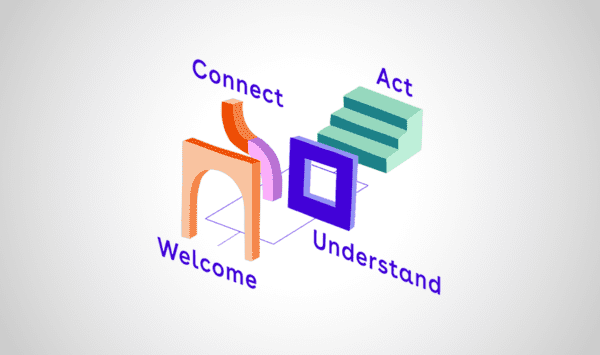
Discussions of digital space often focus on eliminating troubling content or improving the user-friendliness of the design. We’re proposing that digital spaces, like the physical spaces we inhabit, should use public-friendly design.
This idea underpins Civic Signals, a project of the National Conference on Citizenship and the Center for Media Engagement. As part of this project, Civic Signals released the results of a two-year-long study, the largest global survey of social media superusers to date, which uncovered users’ perceptions of the strengths and weaknesses of many of today’s top online platforms.
The research is centered around 14 design principles (“signals”) that together encompass what thriving, healthy social media platforms need to aspire to, from ensuring users’ safety to showing reliable information and bridging connections between groups. The signals were developed through an extensive review of existing literature and research, as well as interviews and feedback from experts across a number of fields and global vantage points and focus groups across five countries.
The 14 signals were grouped into four key building blocks: Welcome, Connect, Understand, and Act. These four building blocks and the 14 signals they represent don’t work on their own. A truly thriving, mutually beneficial digital public space will build on many, if not all, of them. The Civic Signals framework is intended to highlight these important qualities so that we can bring more of them to our digital spaces.
So what does a public-friendly digital space look like when the four building blocks work in harmony? A flourishing digital public space should be welcoming and safe for diverse publics, help us understand and make sense of the world, connect people near and far across hierarchies and divides, and enable us to act together.
BUILDING BLOCK: WELCOME
The first responsibility of a digital space is to create an experience where people feel, at a bare minimum, welcome and safe. Then it must make them feel comfortable and secure enough to stick around. To be truly public, a space must be accessible, inviting, and hospitable. The four foundational welcome signals help us assess how well a space meets these goals.
Signal 1: Invite everyone to participate
When people from a broader range of viewpoints contribute their perspectives, we can learn about new topics and experiences, online resources can be shared more equitably, and tolerance and trust may increase. We need to consider how digital spaces design for social inclusion and provide opportunities for all of us to take part in digital society, regardless of background — and especially for people who are typically disadvantaged. Learn more.
Signal 2: Ensure people’s safety
The protection of digital participants from harm or danger ranging from malware, identity theft, and harassment to sexual victimization and exposure to violent material. Learn more.
Signal 3: Encourage the humanization of others
When we see the humanity in others, we’re more likely to treat them justly. Dehumanization contributes to discrimination and violence, but humanization helps drive reconciliation and peacebuilding after social conflicts. We need to consider how spaces recognize and affirm the humanity of other people. Learn more.
Signal 4: Keep people’s information secure
When people can trust that their information is secure, they are more likely to share more about themselves. When information is not secure, people can be blackmailed, embarrassed, defrauded, or attacked. Learn more.
BUILDING BLOCK: CONNECT
Connect focuses on the connections a digital space helps people form — with each other, with resources, and with power. Digital public spaces bring both people and resources together in ways that physical spaces often can’t. But simply bringing things together isn’t where the work of connection ends.
Signal 5: Cultivate belonging
People who feel like they belong have higher self-esteem; those who feel less belonging perceive daily life as more stressful, act more aggressively and with less self-control, and are at a greater risk of mental health concerns. We need to design digital spaces that foster connection to others and offer a sense of security in your place in the world. Learn more.
Signal 6: Build bridges between groups
Bridges are social connections along which information (like job opportunities) can travel. They can create social capital by exposing people to members of other groups, and increase social trust. Instead of being wary of those from other groups, we need to design connections that encourage the sharing of resources and information that can benefit everyone, especially between groups that might not ordinarily connect. Learn more.
Signal 7: Strengthen local ties
When people are strongly connected to the place they live, there are better health outcomes, improvements in public safety, increased civic involvement, and enhanced resilience in the face of disaster. Locally connected people are more likely to invest in keeping their communities safe, vibrant, and healthy. Learn more.
Signal 8: Make power accessible
When powerful people and institutions are accessible to the public, the powerful are more likely to understand the full breadth of public needs and to be responsive, and members of the public are more likely to feel empowered and inclined to voice their concerns. Learn more.
BUILDING BLOCK: UNDERSTAND
Important information about our world is increasingly communicated in digital spaces. It’s crucial that those spaces help us make sense, together, of the world around us. We don’t all have to agree with each other. But our digital spaces should help us better understand each other and provide context that helps us agree on the fundamental shared reality of what we’re seeing and experiencing.
Signal 9: Elevate shared concerns
When an issue is brought to the attention of people who didn’t previously know about it or consider it important, it increases understanding between groups and the potential for social or political action. Learn more.
Signal 10: Show reliable information
Mis- and disinformation travel faster than true information, and false beliefs, once formed, are difficult to change. Reliable information helps to inform members of the public so they can make good decisions, decide how and when to engage politically, and inoculate themselves against attempts to deceive. We need to design verification processes based on the best available evidence, and for which the production process is transparently disclosed. Learn more.
Signal 11: Build civic competence
For democracies to flourish, people need to understand how to engage in public life. Civic competence encourages effective political participation by helping citizens build reasoned opinions and make policy and candidate choices based on them. It also provides insight into how to be involved. Learn more.
Signal 12: Promote thoughtful conversation
Thoughtful conversation leads to a more informed public, boosts cross-group respect and tolerance, and increases the legitimacy of democratic decisions. Deliberative exchanges are often seen as an indicator of democratic health. We need to design for interactions among people with differing views that shed light on why people believe what they do and involve the consideration and recognition of others’ perspectives. Learn more.
BUILDING BLOCK: ACT
When a public space successfully welcomes and connects disparate groups, and facilitates access to power while promoting mutual understanding, we are inspired to take action — proactively and reactively. Act’s signals consider how online behavior translates into physical spaces, inspiring us to work together to support our own communities and others’, and to become better, more informed, compassionate, and involved citizens of the world around us.
Signal 13: Boost community resilience
Many communities will encounter adversity; resilience allows communities to care for individual citizens more effectively and return to a normal, healthy state more quickly and fully. We need to design and measure how digital spaces allow a community to recover from significant stress or adversity, such as natural disasters, public health emergencies, or violence. Learn more.
Signal 14: Support civic action
Not only does civic action make communities more healthy in their own right, but it can also increase interpersonal trust and make governments more efficient, responsible, and responsive to citizens’ needs. Communities where people are more civically active tend to be safer, healthier, and stronger economically. We need to design and measure how digital spaces support action to address issues of public concern — from volunteering to attending community meetings to co-creation of new spaces and institutions. Learn more.
Read more on the survey methodology.
Read more on the focus group methodology.




